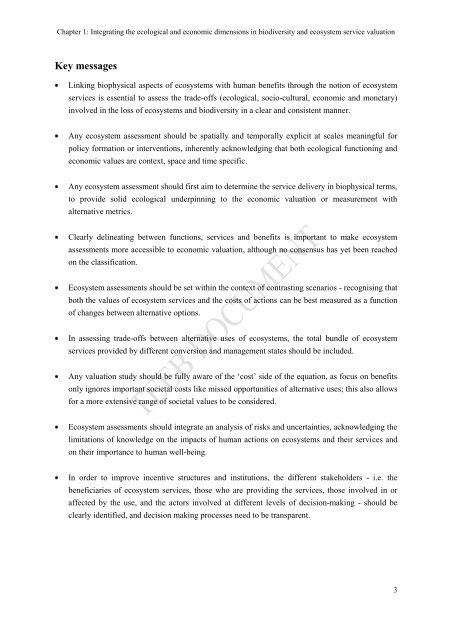Chapter 1 Framework of integration of ecology and economy ... - TEEB
Chapter 1 Framework of integration of ecology and economy ... - TEEB
Chapter 1 Framework of integration of ecology and economy ... - TEEB
You also want an ePaper? Increase the reach of your titles
YUMPU automatically turns print PDFs into web optimized ePapers that Google loves.
<strong>Chapter</strong> 1: Integrating the ecological <strong>and</strong> economic dimensions in biodiversity <strong>and</strong> ecosystem service valuationKey messagesLinking biophysical aspects <strong>of</strong> ecosystems with human benefits through the notion <strong>of</strong> ecosystemservices is essential to assess the trade-<strong>of</strong>fs (ecological, socio-cultural, economic <strong>and</strong> monetary)involved in the loss <strong>of</strong> ecosystems <strong>and</strong> biodiversity in a clear <strong>and</strong> consistent manner.Any ecosystem assessment should be spatially <strong>and</strong> temporally explicit at scales meaningful forpolicy formation or interventions, inherently acknowledging that both ecological functioning <strong>and</strong>economic values are context, space <strong>and</strong> time specific.Any ecosystem assessment should first aim to determine the service delivery in biophysical terms,to provide solid ecological underpinning to the economic valuation or measurement withalternative metrics.Clearly delineating between functions, services <strong>and</strong> benefits is important to make ecosystemassessments more accessible to economic valuation, although no consensus has yet been reachedon the classification.Ecosystem assessments should be set within the context <strong>of</strong> contrasting scenarios - recognising thatboth the values <strong>of</strong> ecosystem services <strong>and</strong> the costs <strong>of</strong> actions can be best measured as a function<strong>of</strong> changes between alternative options.In assessing trade-<strong>of</strong>fs between alternative uses <strong>of</strong> ecosystems, the total bundle <strong>of</strong> ecosystemservices provided by different conversion <strong>and</strong> management states should be included.Any valuation study should be fully aware <strong>of</strong> the „cost‟ side <strong>of</strong> the equation, as focus on benefitsonly ignores important societal costs like missed opportunities <strong>of</strong> alternative uses; this also allowsfor a more extensive range <strong>of</strong> societal values to be considered.Ecosystem assessments should integrate an analysis <strong>of</strong> risks <strong>and</strong> uncertainties, acknowledging thelimitations <strong>of</strong> knowledge on the impacts <strong>of</strong> human actions on ecosystems <strong>and</strong> their services <strong>and</strong>on their importance to human well-being.In order to improve incentive structures <strong>and</strong> institutions, the different stakeholders - i.e. thebeneficiaries <strong>of</strong> ecosystem services, those who are providing the services, those involved in oraffected by the use, <strong>and</strong> the actors involved at different levels <strong>of</strong> decision-making - should beclearly identified, <strong>and</strong> decision making processes need to be transparent.3
















